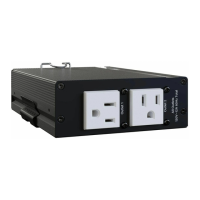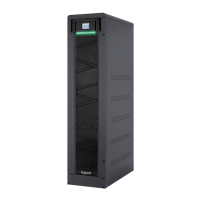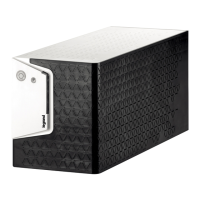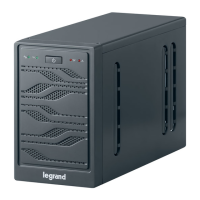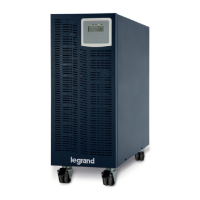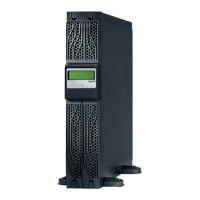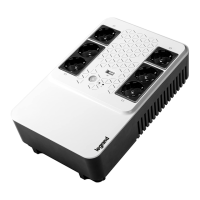
Do you have a question about the LEGRAND Archimod and is the answer not in the manual?
General introduction to the LEGRAND® UPS Archimod® product and its features.
Outlines the manual's objective to guide safe usage and routine maintenance.
Instructions on storing the manual safely and keeping it accessible for consultation.
Explains that the manual reflects the state of the art at the time of market introduction.
Manufacturer's availability for information and user suggestions.
Indicates where to find equipment identification data.
Details user responsibilities for warranty compliance and manufacturer liabilities.
States restrictions on reproduction and disclosure of manual content.
Explains automatic input recognition of voltage, frequency, and phases.
Describes how to select output configuration via the display.
Lists essential checks before powering up the UPS.
Step-by-step guide for starting the UPS after configuration.
Overview of the modular, redundant, and expandable Archimod® UPS system.
Details on the power module, its functional blocks, and Plug & Play capability.
Visual representation of different Archimod® UPS models.
Table listing general, input, and output characteristics of the UPS.
Description of RS232, relay, logic level, and communication interfaces.
Information and warnings regarding the CAN BUS connector.
General safety advice and warnings before operating the equipment.
Explains warning, attention, and indication symbols used in the manual.
Lists relevant safety and EMC standards for UPS.
Defines roles and qualifications for personnel working with the UPS.
Lists essential personal protective equipment (PPE) for safe operation.
Describes workplace safety signs and on-board equipment labels.
Discusses residual risks and the importance of adhering to manual instructions.
Provides general warnings regarding equipment operation and maintenance safety.
Information on emergency procedures, including first aid and fire prevention.
Guidance on inspecting the UPS and packaging for damage upon delivery.
Conditions and limits for safely positioning the UPS unit.
Step-by-step procedure for unpacking and positioning the UPS.
List of items to verify in the UPS and battery cabinet packages.
Safe handling procedures for the UPS equipment.
Guidelines for storing the UPS and its batteries.
Essential safety rules and regulations before commencing installation.
General guidance on making electrical connections to the UPS.
Pre-connection checks for voltage, frequency, earthing, and protection.
Mandatory procedure for connecting the earth cable.
Notes on connecting loads, ensuring power capacity, and using disconnectors.
Instructions for installing external battery cabinets.
Requirements for adequately protecting the UPS and its accessories.
Default configuration details for three-phase input/output connections.
Instructions for configuring three-phase input/single-phase output.
Configuration for single-phase input/single-phase output.
Configuration for single-phase input/three-phase output in 120° mode.
Configuration for single-phase input/three-phase output in independent phases mode.
General notes on wiring and securing cables.
Instructions for connecting the Emergency Power Off (E.P.O.) device.
Description of the Service Mode for setup and software upgrades.
Overview of accessing the main menu and navigating through UPS status pages.
Details on how to view UPS information like model, firmware, and configuration.
Configuration options for startup, output, input, and bypass settings.
Information about individual power modules, including status and measurements.
How to view and delete events and alarms logged by the UPS.
Functions for battery testing, calibration, and display tests.
Procedure for exiting the UPS session and securing settings.
How to control individual output phases when configured as three independent phases.
Step-by-step instructions for safely shutting down the UPS.
Table explaining status indicators, power module LEDs, and acoustic signals.
List of messages displayed on the unit and their meanings/causes.
Introduces maintenance procedures and emphasizes authorized personnel.
User-level preventive maintenance tasks, mainly visual checks.
Essential periodic inspections to ensure reliability and operating life.
Procedure for replacing power modules without interrupting load power.
Steps for using manual bypass for maintenance.
Procedures for installing or replacing battery boxes.
Guidelines for the proper disposal of used batteries.
Instructions for dismantling the UPS unit itself.
Guidance on disposing of electronic components like control panels.
Table showing recommended cable sizes based on power and phases.
Table listing recommended battery fuse ratings.
Table for battery fuse ratings for Archimod® BATTERY cabinets.
Table for battery fuse ratings for specific battery configurations.
Table for recommended input automatic breakers based on UPS power.
Table specifying differential current requirements for breakers.
Table detailing battery current and recommended cable sections.
